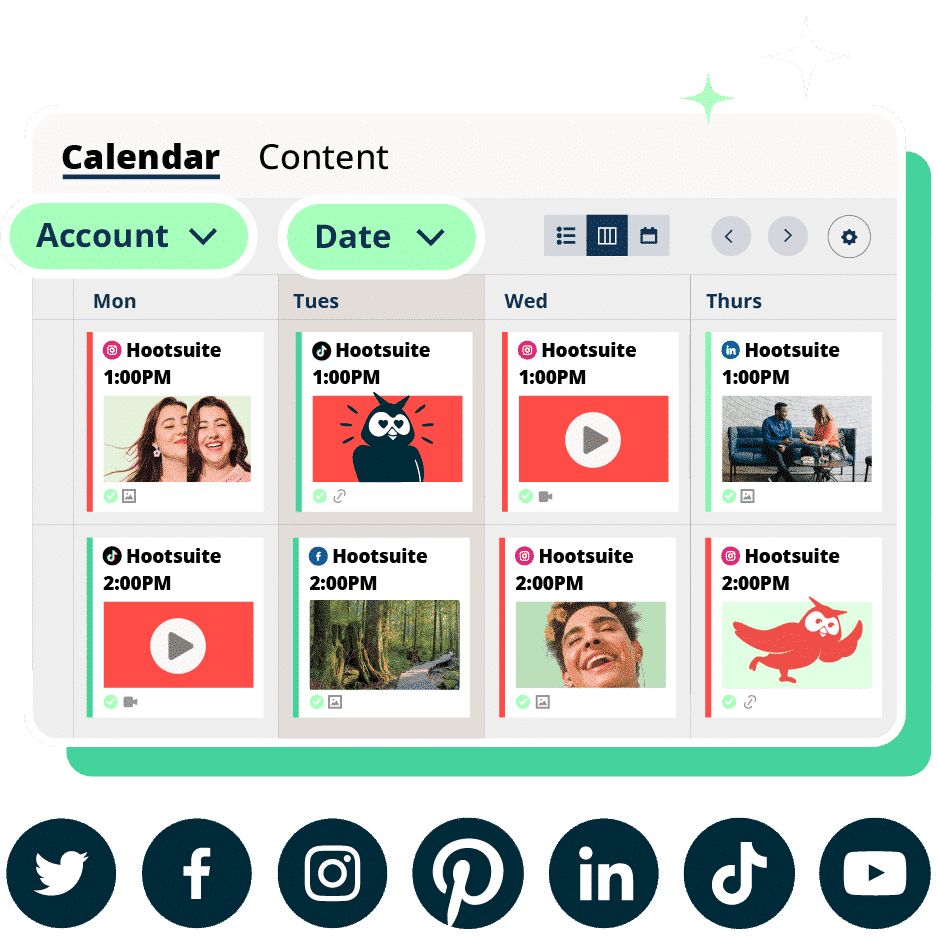Ready for a deep dive into Pinterest demographics? If you want to incorporate Pinterest into your social strategy, you’re in the right place.
Sure, Pinterest may not boast the same user hours as Facebook or share TikTok’s hype. Still, the platform remains a hidden gem for marketers targeting certain audience demographics. If you’re looking for higher-spending millennials, for example, this app is for you. The Pinterest statistics don’t lie.
Before you create your next campaign, take a look at our breakdown of Pinterest user demographics to help you reach your target audience. You’ll find a definitive answer to “Who is using Pinterest?” here.
General Pinterest demographics
1. Most Pinterest users have some college education
26% of U.S. adults who say they use Pinterest have a high school education or less, while 42% have some college education, and 38% are college graduates.
2. 28% of U.S. adults who identify as Black say they use Pinterest
Who uses Pinterest? 36% of Caucasian, 32% of Hispanic, and 30% of Asian-identifying adults report using Pinterest.

Source: Pew Research
Since Pinterest’s user base includes a significant representation of Black, Caucasian, Hispanic, and Asian-identifying adults, creating culturally inclusive and diverse content is key.
Highlighting products or ideas that cater to various cultural backgrounds, holidays, and traditions can help you reach a broader audience. Emphasizing diversity in your visual and textual content will also appeal to Pinterest’s diverse users.
3. Pinterest users are open-minded but undecided
People on Pinterest are eager for new ideas, which means they want to hear from you. In fact, 96% of top Pinterest searches are unbranded! This means there’s plenty of opportunity for you to pitch your product to all Pinterest audience demographics.

Source: Pinterest
Focus on creating content that emphasizes the solution or value your product offers without the hard sell. Utilize SEO strategies by incorporating trending and generic keywords related to your product’s utility, making it discoverable to those seeking inspiration.
4. 85% of users say Pinterest is where they go to start a new project
People who come to this platform are eager for new ideas, products, and ways to complete their projects. Make your content valuable. If you sell fabric, give them sewing patterns. If you sell clothing, give them styling options.
You can create partnerships with adjacent brands to give people an all-in-one solution. If you sell building materials, maybe you partner up with a brand that sells tools, and a brand that sells plants. You can put together a full “how to build raised garden beds” guide and target DIY plant lovers.
Pinterest users are primed to create, so turn what you offer into an easy solution.
5. Pinterest has 498 million users
How many users does Pinterest have? 498 million! That’s nearly five million people who are ready and willing to engage with your content.
Pinterest age demographics
6. 35% of adults in the U.S. use Pinterest
Just over a third of adults in the U.S. use Pinterest, which actually beats TikTok by 2%. If you’re trying to target millennials, you may want to consider cutting your TikTok budget and focusing your efforts on Pinterest instead.

Source: Pew Research Center
If you’re trying to target millennials, you may want to consider cutting your TikTok budget and focusing your efforts on Pinterest instead.
7. The majority of Pinterest’s user base is between 25 and 34 years old
What do all 24 and 34-year-olds have in common? They love to pin. If you can tailor your marketing to this demographic, you’ll find a welcoming audience on Pinterest.

Source: Statista
Catering to young adults and millennials could include career advancement tips, home decor, parenting advice, and lifestyle content.
8. 40% of adults aged 30-49 use Pinterest
Don’t ignore the 30-49 age bracket, who make up the second highest age demographic on Pinterest. Content aimed at these groups could include financial planning, luxury travel, and health and wellness.
9. Gen Z makes up 42% of Pinterest’s monthly active users
If you’re going to target Gen Z, then tailor your content to be vibrant, authentic, and socially aware. Incorporate trending topics, social issues, and environmentally sustainable practices in your content to resonate with this Pinterest target audience. Using short, captivating videos is effective in engaging Gen Z users.
10. 70% of Pinterest’s luxury audience is under 35 years old
Ensure that your luxury content is modern, tech-savvy, and aligns with the values and aesthetics of a younger demographic. Highlighting sustainability, craftsmanship, and the story behind luxury products can appeal to this audience’s desire for depth and authenticity.

Source: Pinterest Newsroom
11. 44% of millennial Pinners have purchased a product they saw on Pinterest
This stat underscores the platform’s influence on purchasing decisions. Create content that resonates with millennial values such as sustainability, work-life balance, and mental health.
Offer value through educational content, DIY projects, and lifestyle inspiration that aligns with millennial interests and challenges.
12. 33% of adults aged 50-64 and 21% of adults aged 65+ use Pinterest
While these age groups may be smaller on Pinterest, they represent a significant market with disposable income.
Tailor content to interests that may appeal to these demographics, such as retirement planning, gardening, travel, and health and wellness. Ensure your content is accessible, with clear visuals and straightforward language.
Pinterest gender demographics
13. 76% of Pinterest’s user base is female
Given that 76% of Pinterest’s user base is female, content should cater heavily towards interests commonly associated with female-identifying people without stereotyping.
The classics include fashion, beauty, home decoration, recipes, and DIY projects but don’t limit your marketing to ‘traditional’ interests like these. Women’s health, female entrepreneurship, and the realities of being a woman in the workplace are some ideas.
Think outside the box, or better yet, ask women what they want to see. Maybe it’s content created for them in traditionally male-dominated spaces, like woodworking or how to style a man’s suit, for ladies.

Source: Statista
14. Women are much more likely to use Pinterest than men
In fact, 50% of women but only 19% of men reported actively using Pinterest. But that doesn’t mean men ain’t pinnin’. You can dedicate 20% of your time marketing to the roughly 20% of men who are on Pinterest.
Pinterest income demographics
15. 1 in 3 Pinterest shoppers have an average annual income of $100,000 or more
With a significant portion of users having an income of $100,000 or more, luxury brands have a fertile ground here. Content that showcases high-end products, luxury travel, premium services, and exclusive experiences can attract this demographic.
Don’t forget about the lower-income folks, too. Users making less than $30k sit at 27%, between $30k and $69,999 are at 34%, and $70k-$99,999 are at 35%.
Pinterest location demographics
16. Most Pinterest users live in the U.S.
As of January 2024, there were over 89 million Pinterest users in the United States, making it the country with the most Pinterest active users by far. Ranking second was Brazil, with 37.14 million users, followed by Mexico, Germany, and France, respectively.
17. Pinterest users almost equally report living in urban, suburban and rural areas
31% of U.S. adults who say they use Pinterest are living in urban areas, while suburban and rural are both at 36%.
Since Pinterest users are almost equally distributed across urban, suburban, and rural areas in the U.S., your content shouldn’t overly cater to one community. Include a mix of content that appeals across the board, from urban living and gardening in small spaces to outdoor adventures and suburban home projects.
18. Pinterest is most popular in the Netherlands
The Netherlands loves Pinterest, where the platform has a 41% penetration rate.
You calculate the penetration rate of a country by dividing the total number of social media users by the total population. This shows how popular the platform is within the country.
Luxembourg and Finland are second and third, with penetration rates of 38% and 31%, respectively.
If you’re targeting demographics within the Netherlands, Luxembourg, or Finland, then Pinterest should be a pillar in your social strategy.

Source: Statista
Pinterest shopper analytics
19. Pinterest ads bring in 11.4x more prospects than competing social
The data suggests Pinterest ads are highly effective in driving prospects. Emphasize creating visually appealing ads that offer inspiration or solve problems.
Since Pinterest is a prime destination for luxury shopping inspiration and brand discovery, ensure your ads are informative, inspirational, and subtly persuasive, highlighting the uniqueness of your brand or product.

Source: Pinterest for Business
20. Brands are still skeptical about advertising on Pinterest
Is a brand a sort of demographic? Maybe, maybe not, but whatever your opinion is, this stat should be of interest regardless.
The skepticism brands have towards advertising on Pinterest could be an opportunity for you to stand out with less competition.
21. Pinterest is the #1 destination for luxury shopping inspiration
Brands should leverage this by creating high-quality, aspirational content that showcases luxury products and lifestyles. Emphasize the exclusivity and unique value of your goods.
22. 80% of Pinners have discovered a new brand or product on Pinterest
This is more of a psychographic, but shoppers are of a curious nature. Your strategy should focus on visibility and discovery. Use keywords strategically in your pins and descriptions to increase the chances of appearing in search results.
Regularly update your boards with fresh content, and consider leveraging Pinterest’s paid promotion options to increase your reach.
23. People want to shop by body type
Pinterest has been experimenting with AI to allow users to browse by body type specificity. They report that “engagement among users utilizing the body type filter was 66% higher per session.” Searches using hair patterns and skin-tone filters rose 41% and 51% YoY.
People want personalized results; brands can capitalize on this by providing samples of their products used by different body and hair types. The stats show: It pays to be inclusive.
Want more? Try these Pinterest stats to improve and refine your business strategy.
Save time managing your Pinterest presence using Hootsuite. Compose, schedule, and publish Pins, create new boards, Pin to multiple boards at once, and run all your other social media profiles — all from one intuitive dashboard. Try it free today.








